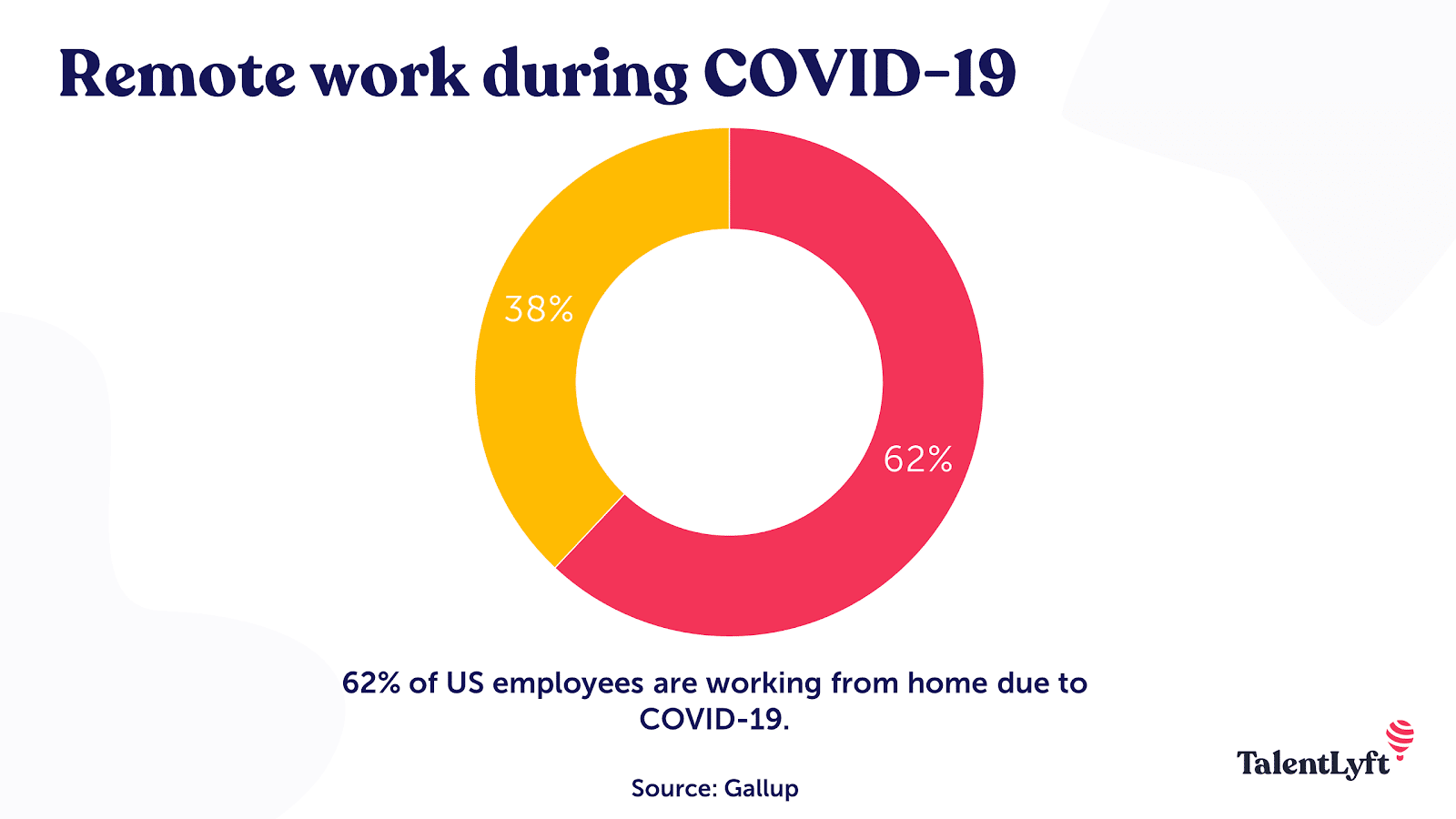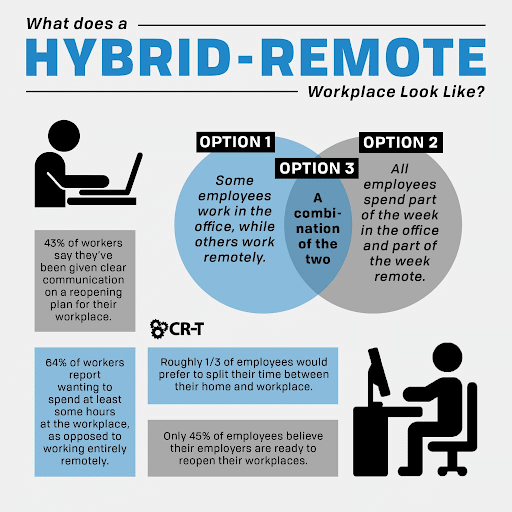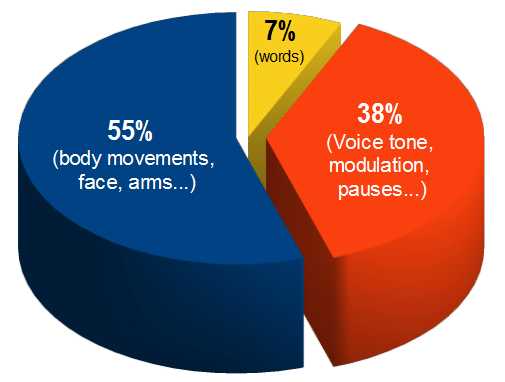It’s no secret that modern workplaces are changing rapidly.
Forward-thinking tech companies from Austin or Silicon Valley have for some time been steadily embracing remote work approaches, but recent global events have catapulted these changes into the mainstream.
As a result, most of us have been working from home, at least in some capacity, over the last year.

But, with vaccines being rolled out and countries around the globe beginning to consider what life looks like post-pandemic, companies are facing a tough question.
Is it time to go back to the office?
Work from home approaches have delivered benefits to companies and employees alike, so it follows that the answer to that question will not be a resounding yes.
If you’re considering moving toward a hybrid work methodology, then you’ve no doubt got a few challenges to solve. Among them is how to manage communication effectively in the hybrid workplace.
This article will outline some common challenges to communication presented by the hybrid workplace and argue for the need for face-to-face communication in this environment. We’ll also discuss six tips for improving communication within your hybrid workplace.
What is a hybrid workplace?
The hybrid workplace is a relatively new phenomenon that combines two methods of working: remote work and the traditional office environment.
In the traditional model, all employees come into the office and complete their work each day.
In the remote working model, employees work from wherever they wish. This might be at a coworking space, in their home office, or a local library.
A hybrid workplace, therefore, sits somewhere in between these two models. Employees in a hybrid workplace come into the office occasionally, typically for meetings with other staff members or managers, and complete the rest of their work from home or another location.

The finer details depend on the company itself. For example, some hybrid workplaces might have employees that work two days per week in the office, whereas others might reserve office time for group work and meetings, regardless of how often this is required.
It’s true, too, that not all employees within a hybrid workplace will spend the same amount of time in the office.
For example, some might work from home four days per week and spend just one in the office, whereas another team member might do the opposite. Indeed, some hybrid workplaces are made up of both entirely remote workers and in-office employees.
While this work methodology brings several benefits, such as enhanced productivity and a better work-life balance for employees, it does present some challenges.
Challenges to communication in a hybrid workplace
Company owners and executives considering setting up a hybrid workplace often have a few concerns. Many of these revolve around visibility, accountability, and, of course, communication challenges.
After all, if an employee isn’t in the office, won’t that make communicating with them harder?
The answer is a little more complex than a binary yes or no, so let’s examine the six main communication challenges faced by hybrid workplaces.
1. Loss of cues from the tone and body language
When employees aren’t in the workplace, most work communications happen over the phone, video calls, or team messaging apps.
This is clearly problematic. We know that only 7% of communication exists in what we say. 38% comes from tone of voice, and a massive 55% comes from body language.

Messaging apps are devoid of body language and, for the most part, tonal cues (though we have emojis and GIFs to help out there).
Phone calls are slightly better, bringing in the tone of voice element, while video calls are another notch up again.
However, technological limitations still reduce our ability to convey meaning through tone of voice and body language.
Imagine the typical video meeting, for example, where everyone attending is confined to a small box, converted to a 2D image, with less than half of their body displayed on the camera. As a result, there’s a lot of body language left unseen.
2. Asynchronous communication
A lot of the communication that happens in the office environment is instant.
If you want to ask Dave a question, for example, you’ll find him in his office and ask him.
In the hybrid workplace, communication becomes much more asynchronous.
I fire off an email, Slack message, or voice note and don’t expect to hear back immediately. Chances are, Dave won’t even read it for a couple of hours.
The same delay occurs when he does finally reply. This presents a challenge too urgent communications. It also means that many pieces of communication end up lost. We’ve all forgotten to reply to an instant message that got buried in a barrage of other important discussions.
3. Fully remote vs fully in-house
As we mentioned earlier, hybrid workplaces also consist of fully remote employees and some working from the office five days per week.
This can create an unintentional divide between the two types of workers, often resulting in remote workers feeling excluded.
In this environment, in-house employees are more likely to be seen by their managers as more efficient and productive than their remote counterparts, purely due to visibility.
The impact of this on communication is that those working remotely tend to disengage. They contribute less to group chats, skip out on office lunches, and reply with less urgency.
4. Onboarding and training
In the traditional work environment, the onboarding and training of employees take place in the office.
A single manager generally leads it, but this person typically delegates responsibilities to key staff members performing similar roles. All of this ensures that the new hire can get intimately familiar with their new job.
This kind of communication is much harder for distributed teams. Indeed, many leaders in these environments aren’t necessarily “in the office” from nine to five, making training a new hire difficult.
5. Timezone challenges
One of the benefits of remote work is that companies have access to a larger pool of talent.
That is, they are no longer limited to a small geographic area when hiring. Instead, if the best person for a role lives in Wisconsin and your office is in Arizona, remote workstyles would allow you to take advantage of this person’s skill set without having them relocate.
The problem is that the best person for that role might not be in the same country as your office, let alone the same city. Timezones make this quite tricky.
For example, an office based in Berlin hiring a new team member in Melbourne will find no overlapping meetings during a nine to five workday.
9 am in Berlin is 5 pm in Melbourne, and 9 am in Melbourne is 1 am in Berlin. Therefore, compromise will need to be reached to communicate smoothly between parties in these cities.

6. Reliance on internet connection
Of course, the entire idea of remote work (and therefore hybrid workplaces) is predicated on the idea that teams can collaborate via the internet.
We sort of take the internet for granted these days, expecting that a solid connection will exist wherever we go.
And though this expectation is typically met, there’s hardly a person reading this article that hasn’t been on the other end of a pixelated video call.
Clearly, then, unreliable internet connections present a challenge to communication for a hybrid company.
Why face to face communication becomes essential in a hybrid workplace
The hybrid workplace presents several communication-related challenges.
Managing such an environment will inevitably be focused on maintaining a careful balance between the two work styles.
That is, hybrid workplace leaders will need to realise that, while many benefits come from remote work, communication suffers.
It is, therefore, a case of not throwing the baby out with the bathwater.
Keeping a strong ratio of face to face communication to text-based messaging will ensure:
- More clearly communicated expectations
- Stronger project management
- Enhanced employee engagement
- Improved training and onboarding processes
- Reduced staff turnover
This raises another question, though.
What should communication in the hybrid workplace look like?
Moving to a hybrid workplace model requires careful planning, process development, and the cooperation of all involved.
Let’s look at six key aspects of setting up a hybrid workplace.
1. Hybrid-ready tech stack
If you’re going to have remote workers of any kind, you’re going to need to get your tech stack sorted.
At a minimum, this should include some form of team chat tool, a video platform for holding online meetings, and a project management software package.
Consider how the technology you bring on board will be used, not only for day-to-day work but for a specific company or team events.
Events are still one of the best ways to create a community inside your workplace, whether it’s hybrid or not. If you hire remote employees and want to include them in any celebration, you’ll most likely have to produce a webinar. By using the right webinar software, you’ll create the right experiences for those employees.

2. Clear and consistent communication processes
One of the things that characterise the hybrid workplace is that your team members work from various locations.
This means they’re going to need to access information related to processes and procedures with ease. For example, you don’t want to be getting a call every five minutes from someone asking how to set up a video meeting.
Thus, you must create clear and consistent process documents, some of which should be related to your communication expectations.
For example, you might create a hierarchy of communication types, which dictates when it’s appropriate for team members to call an in-office meeting, when things should be handled over the video, and when something like email or team chat is more appropriate.
Doing so might seem a little arbitrary and perhaps even a little controlling. However, you can communicate that this process is a set of guidelines that will get all team members on the same page regarding communication expectations. This will make collaborating much smoother.
3. Prioritise face to face communication (where appropriate)
A successful hybrid workplace prioritises face-to-face communication where appropriate.
That means that though some meetings perhaps can be done over the video, you’ll opt to hold them in person anyway as the outcome will be more beneficial both to the company and the individuals within it.
4. Adjust employee benefits accordingly
Employee benefits reach beyond salaries and healthcare packages.
Additional benefits might be required for remote and hybrid workers, such as contributions toward home office equipment or travel expense allowances.
Travel expenses to attend face-to-face meetings are normally covered by the company as part of employee benefits. Although this comes at an additional cost for the company, it helps to boost productivity and engagement.
5. Become a feedback-driven organisation
Realise that the first few months (or longer) following the change to a hybrid setup might bring up some growing pains.
It would help if you didn’t lose sight of the benefits of working remotely when this inevitably occurs.
Instead, see these challenges as an opportunity to receive feedback from your team regarding how your company can improve, optimise, and embrace this new way of working.
6. Leaders must set the right example
A hybrid workplace is likely to be incredibly reliant on process, even down to communication.
Managers need to lead by example here. For example, if you set a precedent that rather than calling and interrupting a team member, you should first send them an instant message to make sure they’re available to take your call. Then, you, as the manager, need to show your employees that same respect.
Conclusion
Moving to a hybrid workplace structure will be challenging for any business of any size and anywhere. However, if you know from the outset what the main challenges you’re likely to encounter are, then you’re going to be well-prepared to face them head-on.
Let’s recap the six most important aspects of communication in the hybrid workplace:
- Investing in your tech stack
- Developing clear processes concerning communication expectations
- Make face-to-face communication a priority
- Consider adjusting employee benefit packages
- Ask for feedback for your team during the transition
- Set the right example and lead from the front
Speaking of your tech stack, you’re probably going to need a reliable business communications platform. Check out what RingCentral has to offer remote teams here.
Originally published Jun 24, 2021, updated Jan 17, 2023
